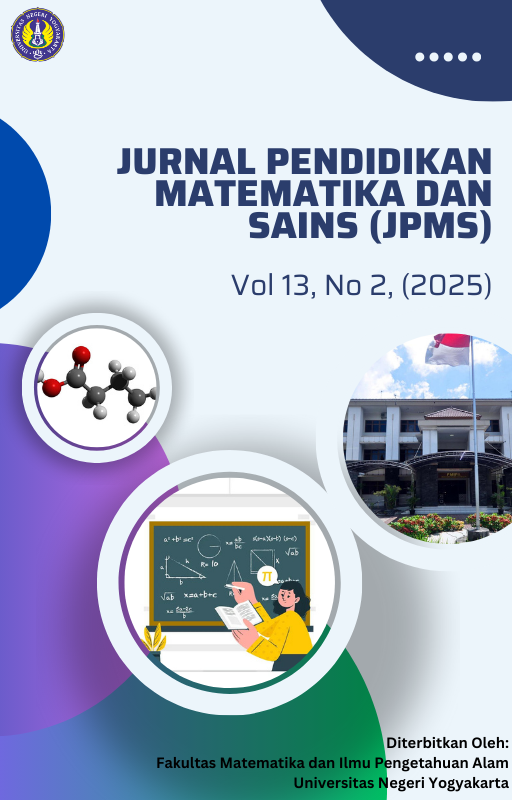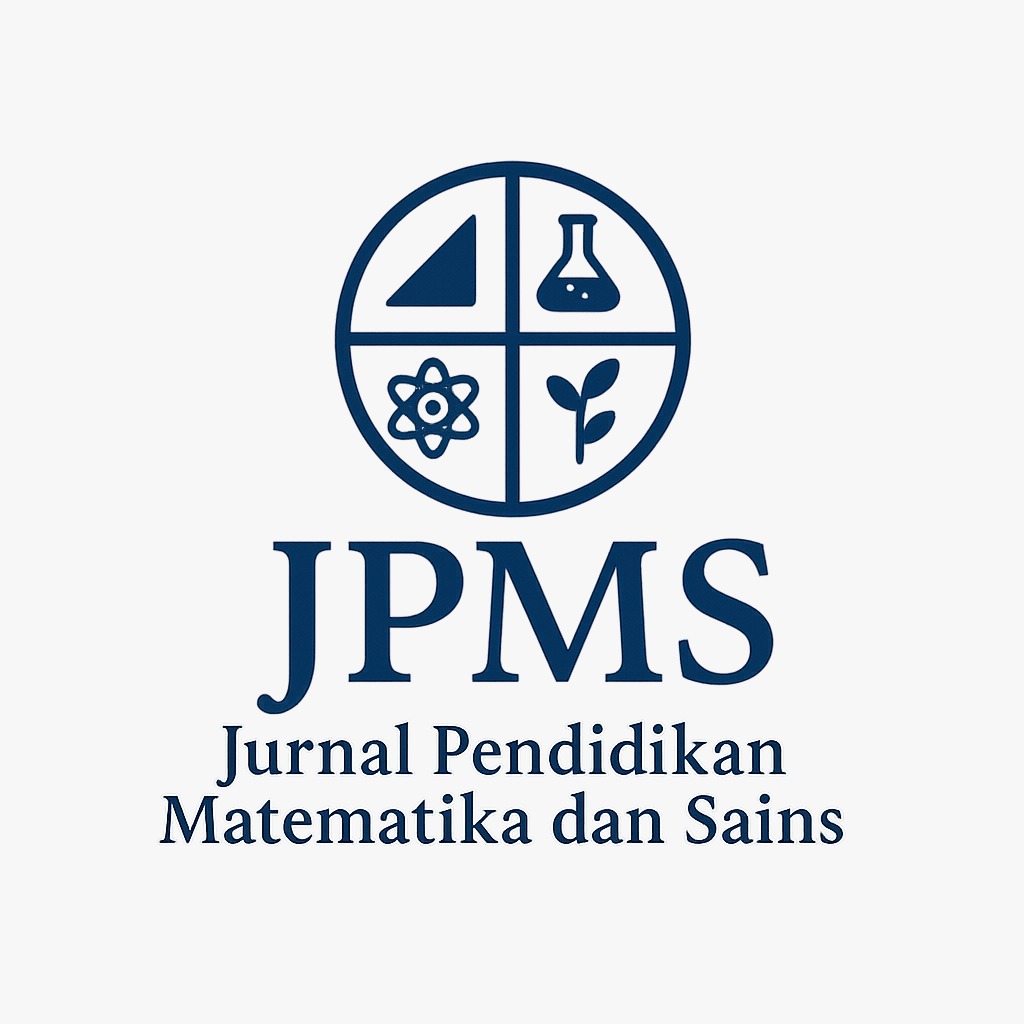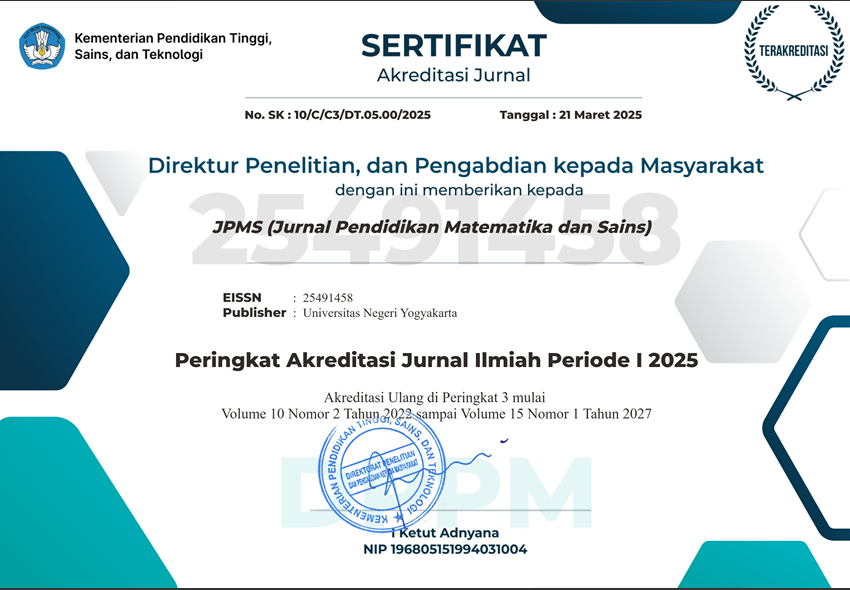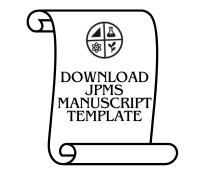Immersive and Experiential Learning: A Review of Project-based Learning and Virtual Reality in Chemistry Education
DOI:
https://doi.org/10.21831/jpms.v13i2.85704Keywords:
Augmented Reality, Chemistry Education, Immersive Learning, Project-Based Learning, Virtual RealityAbstract
This review explores the integration of Project-based Learning (PjBL) and Virtual/Augmented Reality (VR/AR) in chemistry education. By synthesizing findings from eight peer-reviewed studies published between 2020 and 2025, selected through a systematic search using the Dimensions.ai database with specific inclusion criteria, the review highlights how immersive technologies enhance conceptual understanding, motivation, and engagement in student-centered learning environments. Data were collected using a structured literature search, and the findings were analyzed through thematic synthesis based on educational level, technology used, implementation strategies, and reported outcomes. The review reveals that VR/AR, when effectively embedded in PjBL frameworks, allows learners to simulate experiments, visualize abstract molecular structures, and collaborate in meaningful, inquiry-driven projects. However, challenges remain, including limited access to technology, pedagogical integration issues, and educator resistance. The review concludes with recommendations for future research, emphasizing the need for teacher training, inclusive design, and long-term evaluation of immersive PjBL in chemistry education.
References
Alexiou, A., Bouras, C., & Giannaka, E. (2005). Virtual Laboratories in Education. In J.-P. Courtiat, C. Davarakis, & T. Villemur (Eds.), Technology Enhanced Learning (pp. 19–28). Springer US. https://doi.org/10.1007/0-387-24047-0_2
Asino, T. I., Colston, N. M., Ibukun, A., & Abai, C. (2022). The virtual citizen science expo hall: A case study of a design-based project for sustainability education. Sustainability, 14(8), Article 8. https://doi.org/10.3390/su14084671
Babinčáková, M., & Bernard, P. (2020). Online experimentation during COVID-19 secondary school closures: Teaching methods and student perceptions. Journal of Chemical Education, 97(9), 3295–3300. https://doi.org/10.1021/acs.jchemed.0c00748
Castro, M. A. P., Ortega, C. V. S., Torres, M. J. L., & Mejía, F. J. J. (2024). Accesibilidad de la realidad virtual aumentada en la educación universitaria: Estrategias, desafíos y beneficios: accessibility of augmented virtual reality in higher education: Strategies, challenges, and benefits. Revista Scientific, 9(33), Article 33. https://doi.org/10.29394/Scientific.issn.2542-2987.2024.9.33.12.252-275
Dahlman-Höglund, A., Schiöler, L., Andersson, M., Mattsby-Baltzer, I., & Lindgren, Å. (2022). Endotoxin in aerosol particles from metalworking fluids measured with a sioutas cascade impactor. Annals of Work Exposures and Health, 66(2), 260–268. https://doi.org/10.1093/annweh/wxab077
Dermott, G. M., Byrne, A., McLaughlin, R., O’Connor, N., & Griselain, S. (2023). Exploring the use of immersive technologies to enhance the student experience. Ubiquity Proceedings, 3(1). https://doi.org/10.5334/uproc.98
Han, J. Y., & Fung, F. M. (2024). Spatial reality in education – approaches from innovation experiences in Singapore. Chemistry Teacher International, 0(0). https://doi.org/10.1515/cti-2024-0088
Hasan, M. (2024). Innovation and sustainability in engineering & technology: Revolutionizing the future of education through virtual Labs. SSRN Electronic Journal. https://doi.org/10.2139/ssrn.4795012
Howorth, S. K., Marino, M. T., Flanagan, S., Cuba, M. J., & Lemke, C. (2024). Integrating emerging technologies to enhance special education teacher preparation. Journal of Research in Innovative Teaching & Learning, ahead-of-print(ahead-of-print). https://doi.org/10.1108/JRIT-08-2024-0208
Kishoyan, N. A., & University, S. S. (2013). Questions of constitutionally-legal status of auxiliary bodies at president of russian federation. Известия Саратовского Университета. Новая Серия, 13(2), 241–244. https://doi.org/10.18500/1994-2540-2013-13-2-241-244
Kubiliene, E., Ruziene, N., Zilionyte, K., & Radveikiene, I. (2024). Digital support in chemistry education: The distinct project experience. EUREKA Social and Humanities, 3, 61–71. https://doi.org/10.21303/2504-5571.2024.003452
Li, K. C., Wong, B. T. M., & Chan, T. (2023). Teaching and learning innovations for distance learning in the digital era: A literature review. Frontiers in Education, 8, 1198034. https://doi.org/10.3389/feduc.2023.1198034
Lu, A., Wong, C. S. K., Cheung, R. Y. H., & Im, T. S. W. (2021). Supporting Flipped and Gamified Learning With Augmented Reality in Higher Education. Frontiers in Education, 6. https://doi.org/10.3389/feduc.2021.623745
Luis, C. E. M., Mellado, R. C., & Díaz, B. A. (2013). PBL Methodologies with Embedded Augmented Reality in Higher Maritime Education: Augmented Project Definitions for Chemistry Practices. Procedia Computer Science, 25, 402–405. https://doi.org/10.1016/j.procs.2013.11.050
Mondal, H., & Mondal, S. (2025). Adopting augmented reality and virtual reality in medical education in resource-limited settings: Constraints and the way forward. Advances in Physiology Education, 49(2), 503–507. https://doi.org/10.1152/advan.00027.2025
Nechypurenko, P., Semerikov, S., & Pokhliestova, O. (2023). Cloud technologies of augmented reality as a means of supporting educational and research activities in chemistry for 11th grade students. Educational Technology Quarterly, 2023(1), 69–91. https://doi.org/10.55056/etq.44
Paigude, P. S., & Shaikh, Dr. (Mrs. ) N. F. (2019). An Augmented Reality application for Simplifying Engineering Concepts. International Journal of Innovative Technology and Exploring Engineering, 8(9), 3061–3065. https://doi.org/10.35940/ijitee.i8597.078919
Rebello, C. M., Deiró, G. F., Knuutila, H. K., Moreira, L. C. de S., & Nogueira, I. B. R. (2024). Augmented reality for chemical engineering education. Education for Chemical Engineers, 47, 30–44. https://doi.org/10.1016/j.ece.2024.04.001
Rodriguez, W. J. M., Girón, D. C. A., Rojas, Z. R. Z., Ramirez, E. T. S., Rivera, I. P. C., Sanchez, J. L. A., & Soto, F. G. C. (2023). Artificial Intelligence and Augmented Reality in Higher Education: A systematic review. Data and Metadata, 2, 121–121. https://doi.org/10.56294/dm2023121
Soroko, N. V., Soroko, V. M., Mukasheva, M., Montes, M. M. A., & Tkachenko, V. A. (2021). Using of virtual reality tools for the development of steam education in general secondary education. Information Technologies and Learning Tools, 86(6), 87–105. https://doi.org/10.33407/itlt.v86i6.4749
Tene, T., Marcatoma Tixi, J. A., Palacios Robalino, M. de L., Mendoza Salazar, M. J., Vacacela Gomez, C., & Bellucci, S. (2024). Integrating immersive technologies with STEM education: A systematic review. Frontiers in Education, 9. https://doi.org/10.3389/feduc.2024.1410163
Yağcı, A., & Şentürk, C. (2023). Fen Bilimleri (Fizik-Kimya-Biyoloji) Eğitiminde Metaverse. EDUCATIONE, 2(2), Article 2. https://doi.org/10.58650/educatione.1299434
Zhang, N., & Liu, Y. (2024). Design and implementation of virtual laboratories for higher education sustainability: A case study of Nankai University. Frontiers in Education, 8. https://doi.org/10.3389/feduc.2023.1322263
Downloads
Published
How to Cite
Issue
Section
Citation Check
License

This work is licensed under a Creative Commons Attribution-ShareAlike 4.0 International License.
Jurnal Pendidikan Matematika dan Sains allows readers to read, download, copy, distribute, print, search, or link to its articles' full texts and allows readers to use them for any other lawful purpose. The journal allows the author(s) to hold the copyright without restrictions. Finally, the journal allows the author(s) to retain publishing rights without restrictions
- Authors are allowed to archive their submitted article in an open access repository
- Authors are allowed to archive the final published article in an open access repository with an acknowledgment of its initial publication in this journal

This work is licensed under a Creative Commons Attribution-ShareAlike 4.0 Generic License.





